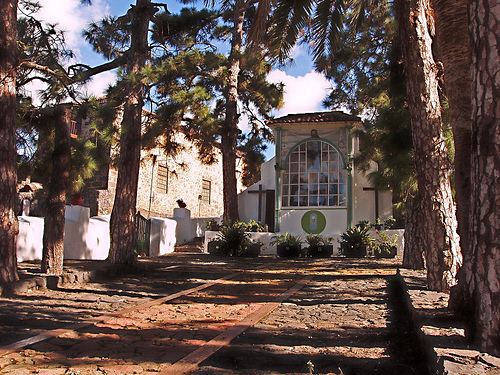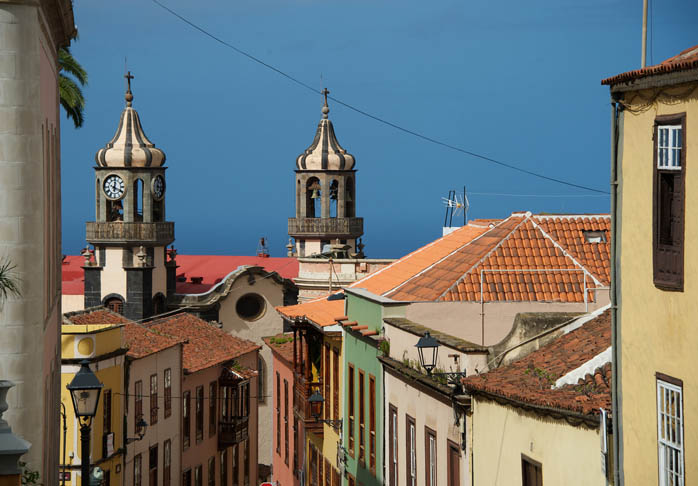Lying in the fertile valley of La Orotava, this is the place, that you just have to visit. Perfectly preserved colonial town with steep sides, cobbled streets is famous not only for its beautiful monuments, but also carpets of colored lava and flowers, which are arranged in the streets and squares of the old town on the occasion of Corpus Christi. Although many companies offer bus tours, it is worth coming to the town alone and with spare time - this place has much more to offer than the Casa de los Balcones shown during trips.
Most tourists who come to La Orotava as part of the organized bus tours only visit the traditional Casa de los Balcones residence, and yet you can really do it in the town (and it's worth it) see so much more. It is best to start sightseeing with a visit to the tourist information office, where the route marked out by the city authorities begins. The first stop on the tour is the tree-lined Plaza de la Constitución. From the observation deck closing it from the north, you can beautifully see the panorama of the town. At the square there is a three-nave Baroque church of San Agustin and the seat of the former Augustine Order, now a community center. A few houses away, tucked behind a beautiful terraced garden rises the 20th-century Liceo de Taoro. Building, seat of a private cultural association, is open to the public. It is worth entering the palace cafe for tea or coffee served on the terrace with a beautiful view, and at the same time see the temporary exhibitions presented inside.
Walking up Escultor Esteves, you walk past Plaza General Franco, where the neoclassical town hall rises. The square planted with flowers is just an announcement of a beautiful botanical garden, Hijuela del Botanico, located right behind the town hall. Garden, in which it grows up 3 thousand. various species of tropical and subtropical plants, called "the botanist's daughter", because it is a branch of the larger botanical garden of Puerto de la Cruz. Hermano Apolinar Street leads to Plaza de San Francisco, where the 17th-century church and monastery are located. Unfortunately, nor the temple, nor the former Franciscan monastery, which was transformed into a psychiatric hospital dedicated to the Holy Trinity (Hospital of the Holy Trinity), are not made available to visitors. However, it is worth going this way, because one of the most beautiful views of the green valley of La Orotava stretches from the terrace, which is rarely visited by tourists, just behind the open main gate of the monastery.
There are many magnificent colonial tenement houses in the city - you can see some of them, because they were converted into museums, hotels or dining options. One of the buildings shared is the beautifully restored 17th-century Casa de los Balcones – the most famous monument of La Orotava. Judgment, actually two houses, are famous for their perfectly preserved traditional wooden balconies, which can be admired from the inner patio. Part of the property is intended for an exhibition and a handicraft shop, in which they are served by shop assistants dressed in traditional regional costumes. Right next to it is the Museo de las Alfombras (Carpet Museum), where you can learn a little more about the history of the local tradition of creating street carpets from colorful volcanic sand and flower petals. Across the street is a similar Casa del Turista, and a little lower on the left hand side of Molino La Maquina, where you can buy gofio made on the spot.
Heading down calle de San Francisco, comes to Casańas Beach, next to which stands the 18th-century church of Nuestra Seńora de la Concepción, considered one of the most beautiful baroque temples in the entire archipelago. At the end of the visit, it is worth taking a walk along one of the prettiest streets – Tomas de Zerolo street, where there are many beautiful 17th and 18th century mansions. At the end of the street there is the Church of Santo Domingo.
The Museo de Artesama Iberoamericana was established in the adjoining building of the former convent
(Ibero-American Handicraft Museum). Inside, five rooms have exhibited items from various South American countries, such as musical instruments, ceramics, materials etc..

